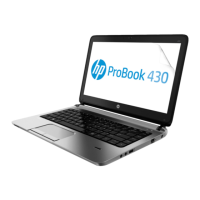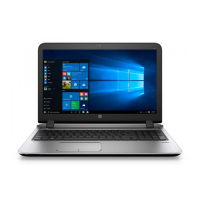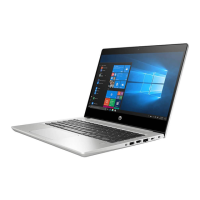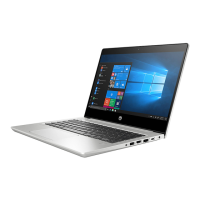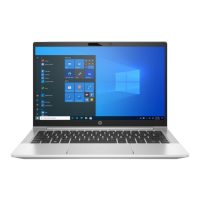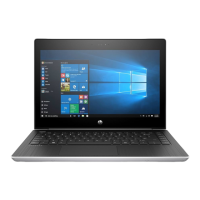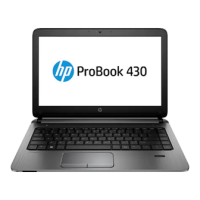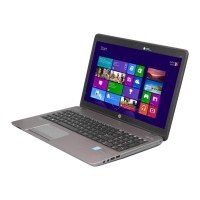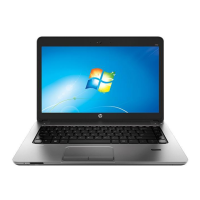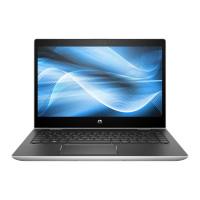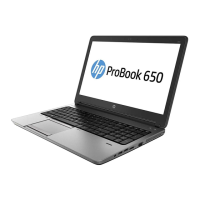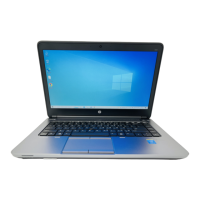Do you have a question about the HP ProBook 430 G1 and is the answer not in the manual?
Details on CPU models, clock speeds, cache, and integrated graphics.
Specifies RAM type, speed, slots, and supported configurations.
Lists supported HDD and SSD types, capacities, and interface.
Lists physical connection ports like USB, HDMI, VGA, and Ethernet.
Covers integrated fingerprint reader and security lock options.
Lists preinstalled OS versions and restore media types.
Identifies external components on the display assembly for Windows models.
Identifies components located on the top surface of the notebook.
Explains the function of various indicator lights on the notebook.
Explains the function of special keys like Fn, Esc, and Windows keys.
Identifies components located on the front edge of the notebook.
Identifies ports and vents on the left side of the notebook.
Identifies ports, audio jacks, and indicator lights on the right side.
Identifies components on the bottom of the notebook, including the service door.
Explains the information found on the service tag and its importance.
Describes the PCID label and its role in system firmware reset.
Provides an exploded view and list of main computer components.
Lists spare part numbers for display panels with and without WWAN.
Lists spare part numbers for various hard drive and SSD options.
Lists spare part numbers for system boards based on processor type.
Lists spare part numbers for memory modules of different capacities.
Lists spare part numbers for WWAN modules.
Provides spare part number for the service door.
Lists spare part numbers for various internal cables.
Lists spare part numbers for hard drives and SSDs.
Lists spare part numbers for items like cases, mice, and AC adapters.
A comprehensive list of spare part numbers with CSR flags.
Lists the necessary tools for component removal and replacement.
Provides instructions on preventing electrostatic discharge damage.
Step-by-step instructions for removing and replacing the notebook battery.
Detailed steps for removing and replacing the notebook keyboard.
Instructions for removing and replacing the hard drive or SSD.
Steps to remove and replace the computer's service door.
Procedure for removing and installing the SIM card for WWAN models.
Instructions for removing and replacing memory modules.
Steps for removing and replacing the WWAN wireless module.
Procedure for removing and replacing the WLAN/Bluetooth card.
Detailed instructions for removing and replacing the top cover assembly.
Steps for removing and replacing the Real-Time Clock (RTC) battery.
Procedure for removing and replacing the fingerprint reader assembly.
Instructions for removing and replacing the audio board.
Steps for removing and replacing the function board.
Procedure for removing and replacing the power button board.
Instructions for removing and replacing the speaker assembly.
Steps for removing and replacing the entire display assembly.
Instructions for removing and replacing the power connector cable.
Detailed procedure for removing and replacing the system board.
Steps for removing and replacing the heat sink assembly.
Guide to accessing and using BIOS setup for Windows 7.
Explains how to navigate and use the Computer Setup utility.
Instructions on how to enter the Computer Setup (BIOS) utility.
Details on keyboard and mouse navigation within BIOS.
Steps to reset BIOS settings to their factory defaults.
Information on how to update the system's BIOS.
Process for downloading and installing BIOS updates via SoftPaqs.
Using system diagnostics for BIOS management and updates.
Method for updating BIOS using the F10 setup utility.
How to check the current BIOS version installed on the system.
Step-by-step guide to downloading a BIOS update from the HP website.
Overview of the main menus and options available in BIOS setup.
How to run diagnostic tests to check hardware functionality.
Guide to accessing and using BIOS setup for Windows 8.
Details on navigating and making selections within BIOS for Windows 8.
Steps to reset BIOS settings to factory defaults for Windows 8.
Information on updating the BIOS for Windows 8 systems.
How to check the current BIOS version for Windows 8.
Guide to downloading BIOS updates for Windows 8.
How to run diagnostic tests for Windows 8 systems.
General physical and operational specifications of the notebook.
Detailed technical specifications for the notebook's display.
Technical specifications for the notebook's hard drive options.
How to find hardware specifications using Device Manager.
Guide to creating recovery media using HP software.
Instructions on how to back up personal files and system data.
Steps to recover the system in case of failure or instability.
How to use built-in Windows tools for recovery and repair.
Procedure for using the F11 key for system recovery.
Instructions for recovery using an external Windows 7 DVD.
Guide to backing up files and creating system images in Windows 8.
Steps to recover the system in Windows 8.
How to use the Windows Refresh feature to restore system stability.
Process to reset the PC to its original state, removing all data.
How to use HP Software Setup to reinstall drivers and software.
Instructions for creating system backups in SLED.
Guide to backing up files and system data in SLED.
Steps to restore the computer to its factory state in SLED.
How to create and use a USB drive for system recovery.
Process to reset the SLED system to its original state.
Steps to enter BIOS setup for managing system security and defaults.
Instructions for clearing HDD contents using BIOS utilities.
Instructions for clearing SSD contents using BIOS utilities.
General requirements for power cord sets applicable globally.
Country-specific requirements for accredited agencies and notes.
Guidelines for the proper disposal and recycling of batteries.
Precautions and instructions for handling and recycling display components.
Details on CPU models, clock speeds, cache, and integrated graphics.
Specifies RAM type, speed, slots, and supported configurations.
Lists supported HDD and SSD types, capacities, and interface.
Lists physical connection ports like USB, HDMI, VGA, and Ethernet.
Covers integrated fingerprint reader and security lock options.
Lists preinstalled OS versions and restore media types.
Identifies external components on the display assembly for Windows models.
Identifies components located on the top surface of the notebook.
Explains the function of various indicator lights on the notebook.
Explains the function of special keys like Fn, Esc, and Windows keys.
Identifies components located on the front edge of the notebook.
Identifies ports and vents on the left side of the notebook.
Identifies ports, audio jacks, and indicator lights on the right side.
Identifies components on the bottom of the notebook, including the service door.
Explains the information found on the service tag and its importance.
Describes the PCID label and its role in system firmware reset.
Provides an exploded view and list of main computer components.
Lists spare part numbers for display panels with and without WWAN.
Lists spare part numbers for various hard drive and SSD options.
Lists spare part numbers for system boards based on processor type.
Lists spare part numbers for memory modules of different capacities.
Lists spare part numbers for WWAN modules.
Provides spare part number for the service door.
Lists spare part numbers for various internal cables.
Lists spare part numbers for hard drives and SSDs.
Lists spare part numbers for items like cases, mice, and AC adapters.
A comprehensive list of spare part numbers with CSR flags.
Lists the necessary tools for component removal and replacement.
Provides instructions on preventing electrostatic discharge damage.
Step-by-step instructions for removing and replacing the notebook battery.
Detailed steps for removing and replacing the notebook keyboard.
Instructions for removing and replacing the hard drive or SSD.
Steps to remove and replace the computer's service door.
Procedure for removing and installing the SIM card for WWAN models.
Instructions for removing and replacing memory modules.
Steps for removing and replacing the WWAN wireless module.
Procedure for removing and replacing the WLAN/Bluetooth card.
Detailed instructions for removing and replacing the top cover assembly.
Steps for removing and replacing the Real-Time Clock (RTC) battery.
Procedure for removing and replacing the fingerprint reader assembly.
Instructions for removing and replacing the audio board.
Steps for removing and replacing the function board.
Procedure for removing and replacing the power button board.
Instructions for removing and replacing the speaker assembly.
Steps for removing and replacing the entire display assembly.
Instructions for removing and replacing the power connector cable.
Detailed procedure for removing and replacing the system board.
Steps for removing and replacing the heat sink assembly.
Guide to accessing and using BIOS setup for Windows 7.
Explains how to navigate and use the Computer Setup utility.
Instructions on how to enter the Computer Setup (BIOS) utility.
Details on keyboard and mouse navigation within BIOS.
Steps to reset BIOS settings to their factory defaults.
Information on how to update the system's BIOS.
Process for downloading and installing BIOS updates via SoftPaqs.
Using system diagnostics for BIOS management and updates.
Method for updating BIOS using the F10 setup utility.
How to check the current BIOS version installed on the system.
Step-by-step guide to downloading a BIOS update from the HP website.
Overview of the main menus and options available in BIOS setup.
How to run diagnostic tests to check hardware functionality.
Guide to accessing and using BIOS setup for Windows 8.
Details on navigating and making selections within BIOS for Windows 8.
Steps to reset BIOS settings to factory defaults for Windows 8.
Information on updating the BIOS for Windows 8 systems.
How to check the current BIOS version for Windows 8.
Guide to downloading BIOS updates for Windows 8.
How to run diagnostic tests for Windows 8 systems.
General physical and operational specifications of the notebook.
Detailed technical specifications for the notebook's display.
Technical specifications for the notebook's hard drive options.
How to find hardware specifications using Device Manager.
Guide to creating recovery media using HP software.
Instructions on how to back up personal files and system data.
Steps to recover the system in case of failure or instability.
How to use built-in Windows tools for recovery and repair.
Procedure for using the F11 key for system recovery.
Instructions for recovery using an external Windows 7 DVD.
Guide to backing up files and creating system images in Windows 8.
Steps to recover the system in Windows 8.
How to use the Windows Refresh feature to restore system stability.
Process to reset the PC to its original state, removing all data.
How to use HP Software Setup to reinstall drivers and software.
Instructions for creating system backups in SLED.
Guide to backing up files and system data in SLED.
Steps to restore the computer to its factory state in SLED.
How to create and use a USB drive for system recovery.
Process to reset the SLED system to its original state.
Steps to enter BIOS setup for managing system security and defaults.
Instructions for clearing HDD contents using BIOS utilities.
Instructions for clearing SSD contents using BIOS utilities.
General requirements for power cord sets applicable globally.
Country-specific requirements for accredited agencies and notes.
Guidelines for the proper disposal and recycling of batteries.
Precautions and instructions for handling and recycling display components.
| Form factor | Clamshell |
|---|---|
| Product type | Laptop |
| Product color | Black, Silver |
| Country of origin | China |
| Bus type | DMI |
| Tjunction | 100 °C |
| Processor cache | 3 MB |
| Processor cores | 2 |
| Processor model | i3-4005U |
| System bus rate | 5 GT/s |
| Processor family | Intel® Core™ i3 |
| Processor series | Intel® Core™ i3-4000 Mobile Series |
| Processor socket | BGA 1168 |
| Processor threads | 4 |
| Processor codename | Haswell |
| Processor frequency | 1.7 GHz |
| Processor cache type | Smart Cache |
| Processor lithography | 22 nm |
| Processor manufacturer | Intel |
| Processor front side bus | - MHz |
| PCI Express slots version | 2.0 |
| Processor operating modes | 64-bit |
| ECC supported by processor | No |
| PCI Express configurations | 4x1, 1x4 |
| Thermal Design Power (TDP) | 15 W |
| Maximum number of PCI Express lanes | 10 |
| Motherboard chipset | - |
| Memory slots | 2x SO-DIMM |
| Internal memory | 4 GB |
| Memory clock speed | 1600 MHz |
| Memory form factor | SO-DIMM |
| Internal memory type | DDR3-SDRAM |
| Maximum internal memory | 16 GB |
| AC adapter included | Yes |
| Intel segment tagging | Enterprise, Professional |
| HDD interface | SATA |
| Storage media | HDD |
| Total storage capacity | 500 GB |
| Compatible memory cards | SD |
| Number of HDDs installed | 1 |
| Display diagonal | 13.3 \ |
| Display resolution | 1366 x 768 pixels |
| Native aspect ratio | 16:9 |
| Display number of colors | 16.78 million colors |
| On-board graphics card ID | 0xA16 |
| Discrete graphics card model | Not available |
| On-board graphics card model | Intel® HD Graphics 4400 |
| On-board graphics card family | Intel® HD Graphics |
| Maximum on-board graphics card memory | 2 GB |
| On-board graphics card base frequency | 200 MHz |
| On-board graphics card DirectX version | 12 |
| On-board graphics card dynamic frequency (max) | 950 MHz |
| Audio system | DTS Sound+ |
| Front camera resolution | 1280 x 720 pixels |
| Wi-Fi standards | 802.11b, 802.11g, Wi-Fi 4 (802.11n) |
| Bluetooth version | 4.0 |
| Ethernet LAN data rates | 10, 100, 1000 Mbit/s |
| Charging port type | DC-in jack |
| USB 2.0 ports quantity | USB 2.0 ports have a data transmission speed of 480 Mbps, and are backwards compatible with USB 1.1 ports. You can connect all kinds of peripheral devices to them. |
| eSATA/USB 2.0 ports quantity | 0 |
| Pointing device | Touchpad |
| Recovery operating system | Windows 8 Pro |
| Operating system installed | Windows 7 Professional |
| Processor ARK ID | 75105 |
| Processor package size | 40 x 24 x 1.5 mm |
| Intel ME Firmware Version | 9.5 |
| Supported instruction sets | AVX 2.0, SSE4.1, SSE4.2 |
| Intel Smart Connect Technology version | 1.00 |
| Intel Smart Response Technology version | 0.00 |
| Battery capacity | 44 Wh |
| Battery life (max) | 8.5 h |
| AC adapter power | 45 W |
| AC adapter frequency | 50 - 60 Hz |
| AC adapter input voltage | 100 - 240 V |
| Cables included | AC |
| Storage temperature (T-T) | -15 - 60 °C |
| Operating temperature (T-T) | 5 - 35 °C |
| Storage relative humidity (H-H) | 10 - 90 % |
| Operating relative humidity (H-H) | 20 - 85 % |
| Sustainability certificates | RoHS, EPEAT Silver, ENERGY STAR |
| Depth | 233.5 mm |
|---|---|
| Width | 325 mm |
| Height | 21 mm |
| Weight | 1500 g |
